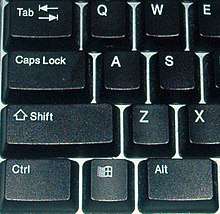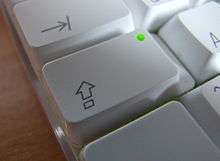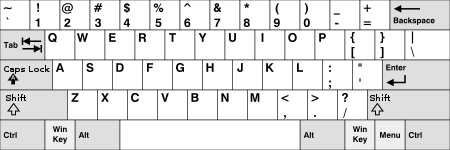Caps lock

Caps Lock is a button on a computer keyboard that causes all letters of Latin-based scripts to be generated in capitals. It is a toggle key: each press reverses its action. Some keyboards also implement a light, so as to give visual feedback about whether it is on or off. Exactly what Caps Lock does depends on the keyboard hardware, the operating system, the device driver, and the keyboard layout. Usually, the effect is the limited to letter keys; letters of Latin-based scripts are capitalised, while letters of other scripts (e.g. Arabic, Hebrew, Hindi) and non-letter characters are generated normally.
History
The Caps Lock key originated as a Shift lock key on mechanical typewriters. An early innovation in typewriters was the introduction of a second character on each typebar, thereby doubling the number of characters that could be typed, using the same number of keys. The second character was positioned above the first on the face of each typebar, and the typewriter's Shift key caused the entire type apparatus to move, physically shifting the positioning of the typebars relative to the ink ribbon. Just as in modern computer keyboards, the shifted position was used to produce capitals and secondary characters.
The Shift lock key was introduced so the shift operation could be maintained indefinitely without continuous effort. It mechanically locked the typebars in the shifted position, causing the upper character to be typed upon pressing any key. Because the two shift keys on a typewriter required more force to operate and were meant to be pressed by the little finger, it could be difficult to hold the shift down for more than two or three consecutive strokes, therefore the introduction of the Shift lock key was also meant to reduce finger muscle pain caused by repetitive typing.
Mechanical typewriter shift lock is typically set by pushing both Shift and lock at the same time, and released by pressing Shift by itself. Computer Caps Lock is set and released by the same key, and the Caps Lock behavior in most QWERTY keyboard layouts differs from the Shift lock behavior in that it capitalizes letters but does not affect other keys, such as numbers or punctuation. Some early computer keyboards, such as the Commodore 64, had a Shift lock but no Caps Lock; others, such as the BBC Micro, had both, only one of which could be enabled at a time.
Behavior

Typical Caps Lock behavior is that pressing the key sets an input mode in which all typed letters are uppercase, if applicable. The keyboard remains in Caps Lock mode and would generate all caps text until the key is pressed again. Keyboards often include a small LED to indicate that Caps Lock is active, either on the key itself or in a dedicated indicators area, where Scroll lock and Num lock indicators are also located. On the original IBM PC keyboard, this LED was exclusively controlled by the keyboard. Since the introduction of IBM AT, however, it is under control of the operating system. Small keyboards, such as netbook keyboards, forgo the indicators to conserve space, instead providing software that gives an on-screen or audio feedback.
In most cases, the status of the Caps Lock key only changes the meaning of the alphabet keys, not that of any other key. Microsoft Windows enforces this behavior only when a keyboard layout for a Latin-based script is active, e.g. the "English (United States)" layout but not the "Persian" layout. However, on certain non-QWERTY keyboard layouts, such as the French AZERTY and the German QWERTZ, Caps Lock still behaves like a traditional Shift lock, i.e., the keyboard behaves as if the Shift key is held down, causing the keyboard to input the alternative values of the keys; example the "5" key generates a "%" when Caps lock is pressed.
Depending on the keyboard layout used, the Shift key, when pressed in combination with a Latin-based letter button while Caps Lock is already on, is either ignored, or nullifies the effect of Caps Lock, so that typed characters are in lowercase again. Microsoft Windows enforces the latter.
While the typical locking behavior on keyboards with Caps Lock key is that of a toggle, each press reversing the shift state, some keyboard layouts implement a combi mode, where pressing a Shift key in Caps Lock mode will also release the Caps Lock mode, just as it typically happens in Shift lock mode.
Some keyboard drivers include a configuration option to deactivate the Caps Lock key. This behavior allows users to decide themselves whether they want to use the key, or to disable it to prevent accidental activation.
In the Unix communities of the ex-USSR countries, Caps Lock key is traditionally used as input language switcher, convenient for usage with touch typing. Support for this is present in KDE,[1] GNOME and other desktop environments. Default Russian, Ukrainian layouts for FreeBSD specifies Caps Lock as input language switcher. In Microsoft Windows, however, third-party utilities are needed to enable this behavior.[2][3] In such configurations, the original Caps Lock function is reached with the ⇧ Shift+⇪ Caps Lock combination.
Precautions
Most apps that request users to input a password do not display it on screen, so as not to expose it to prying eyes. A user who does not pay proper attention to the Caps Lock indicator, however, might end up typing the wrong password (in which all small letters become capital letters or vice versa). As such, help guides, tech support materials, and app user interfaces may include warnings on checking the Caps Lock state before typing a password. In Microsoft Windows login screens, a warning that Caps Lock is on is shown in a balloon near the field. In macOS, when Caps Lock is on, a Caps Lock symbol (⇪) is displayed inside a password field.
Placement
Since its inception, the IBM PC keyboard had a Caps Lock. In the first version for PC/XT, Caps Locks was located to the bottom right of the letter keys area. However, subsequent models switched the places of the Caps Lock key and the Control key. As such, Caps Lock has since been placed on left edge of the keyboard, above the Shift key and below the Tab key, next to letter A. This layout has become the de facto popular standard.
The keyboards of some early computer terminals, including the Teletype Model 33 ASR and Lear-Siegler ADM-3A, the Apple II and a few Apple Keyboard models retained the Control key where PC/XT first had it; Caps Lock was either absent on these device or was placed elsewhere. This layout was preserved for later workstation systems and is often associated with Unix workstations. Keyboards from Sun Microsystems came in two layouts; "Unix" and "PC-style", with the Unix layout having the traditional placing of the Control key and other keys.[4] The Amiga computers all had both the Control key and Caps Lock key in this spot at half the width.
Some users of keyboards with Caps Lock on the left remap the keys to exchange Control and Caps Lock, finding the traditional location more ergonomic for using programs benefiting from use of the Control key. Keyboard layout preferences specifically to address this need are available in some operating systems. Some keyboards even provide a switch on the bottom to logically swap the two keys in hardware.[5][6]
The Happy Hacking Keyboard and the keyboards produced for OLPC XO computers also have the Control key in this location, while not including a Caps Lock.[7] Beginning with the Google Cr-48, Chromebooks have omitted Caps Lock in favor of a dedicated "Search" key.[8]
International Caps Lock Day
June 28 and October 22 are semiannually observed as INTERNATIONAL CAPS LOCK DAY as a parody holiday created in October 2000 by Derek Arnold, a user on Metafilter. The second observation on June 28 was added by Arnold in memory of American pitchman Billy Mays.[9][10][11]
References
- ↑ "Верхом на Debian GNU Linux: Настройка переключателя раскладки в KDE - прощайте, тормоза!". April 1, 2008. Retrieved June 28, 2014.
- ↑ "Переключение раскладки клавиатуры в Windows по Caps Lock: окончательный выбор". December 20, 2013. Retrieved June 28, 2014.
- ↑ "cpswitch". Retrieved June 28, 2014.
- ↑ Sun hardware reference manual
- ↑ "WASD V2/V2B User Guide" (PDF). wasdkeyboards.com. Retrieved 2016-10-24.
- ↑ "Pok3r User Guide" (PDF). vortexgear.tw. Retrieved 2016-10-24.
- ↑ Marti, Don (October 27, 2006). "Doing it for the kids, man: Children's laptop inspires open source projects". Linux World. IDG. Archived from the original on November 22, 2007.
- ↑ Diaz, Jesus (December 7, 2010). "Google wants to take your Caps Lock key away". Gizmodo. Retrieved December 9, 2010.
- ↑ Brian, Matt (October 22, 2010). "Today is INTERNATIONAL CAPS LOCK DAY, but what is it?". Retrieved October 22, 2010.
- ↑ Popkin, Helen A.S. (October 10, 2012). "CAPS LOCK DAY COMES BUT TWICE A YEAR!". NBC News. NBCUniversal News Group. Archived from the original on September 12, 2015. Retrieved September 12, 2015.
- ↑ Hoffer, Steven (June 28, 2011). "CAPS LOCK DAY 2011: Celebrate Capital Letters With TWEETS!". Huffington Post. AOL. Archived from the original on July 22, 2014. Retrieved September 12, 2015.
External links
- c2:CapsLockOff—describes how to remap the Caps Lock key for other purposes.
- CAPS LOCK DAY official site.
- I Hate the CapsLock key
| Wikimedia Commons has media related to Caps lock keys. |
IBM PC keyboard (Windows, US layout) | ||||||||||||||||||||||||
|---|---|---|---|---|---|---|---|---|---|---|---|---|---|---|---|---|---|---|---|---|---|---|---|---|
| Esc | F1 | F2 | F3 | F4 | F5 | F6 | F7 | F8 | F9 | F10 | F11 | F12 | PrtScn/ SysRq |
Scroll Lock |
Pause/ Break |
|||||||||
 |
Insert | Home | PgUp | Num Lock |
∕ | ∗ | − | |||||||||||||||||
| Delete | End | PgDn | 7 | 8 | 9 | + | ||||||||||||||||||
| 4 | 5 | 6 | ||||||||||||||||||||||
| ↑ | 1 | 2 | 3 | Enter | ||||||||||||||||||||
| ← | ↓ | → | 0 Ins |
. Del | ||||||||||||||||||||